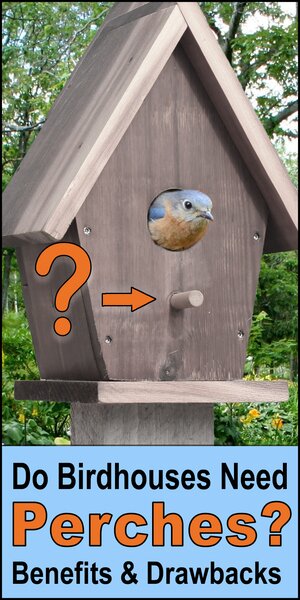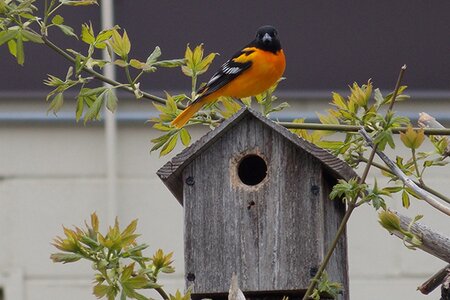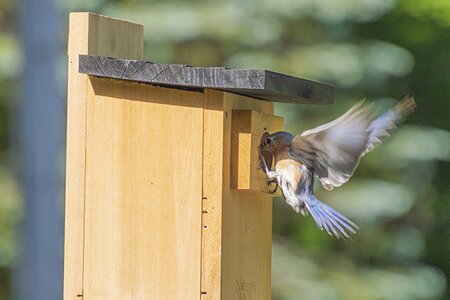Birdhouse Perch (Do Birdhouses Need Perches)
Do birdhouses need perches? A perch is typically a round stick or wooden dowel placed below the entrance hole that allows a bird to balance and rest on before entering the birdhouse. This article will examine the advantages/benefits and disadvantages/drawbacks of adding a perch to your birdhouse, along with the ideal length and placement of a perch. We will also discuss the differences between a perch and a porch. Find more birdhouse and feeder ideas.

Advantages of a Perch on a Birdhouse
- Allows birds to more easily enter and exit a birdhouse.
- Allows birds to rest comfortably by their house. Some birds like purple martins like to perch on or near their houses.
- Allows birds to more easily feed their young (their brood). Young birds have a habit of congregating at the entrance when the food arrives. The ensuing confusion around the entrance hole sometimes results in the parent bird accidentally dropping food onto the ground. A birdhouse perch can reduce such incidents. In one study involving purple martins, birdhouses with a perch reduced the number of dragonflies that accidentally dropped to the ground.
- Provides birds a prominent location to keep an eye on predators and guard their birdhouse.
- Provides a convenient location for birds to call out for mates.
- Allows the parent birds to more easily hang onto the birdhouse and deliver food to the young ones. Especially, when large young ones are clustered around the entrance.
- Allows a bird to land when carrying nesting materials and then push the materials inside.
Disadvantages of a Perch on a Birdhouse
- A perch might make it easier for unwanted birds or predators to enter the birdhouse.
Most cavity-nesting birds can cling to the outside of a wooden birdhouse with or without a perch. - A perch might be more dangerous for the young. Even when fledglings are not ready to fly, they may be tempted to step out onto the perch to escape the heat for instance. This exposes them to predators and may result in young fledglings falling down to the ground.

Birdhouse Perch Length
The ideal birdhouse perch is a round stick, wooden dowel, river cane, bamboo stalk, etc. between 1/4″-1/2″ (0.6cm-1.3cm) in diameter. The length of the birdhouse perch should be between 1.5″-2″ (4cm-5cm) in length.
Birdhouse Perch Placement
The birdhouse perch should be centered 1 to 2 inches (2.5cm – 5cm) beneath the entrance hole.
Round Perches vs Flat Porches
A perch is typically a round stick, wooden dowel, or a piece of wire that is placed below the entrance hole that allows a bird to balance and rest on before entering the birdhouse. Below are two birdhouses that have perches.
A porch is a flat level surface or platform that birds can rest on before entering or existing the birdhouse. Below are two birdhouses that have porches.
Some birds are “perching birds.” For these birds, they prefer to grasp a round perch rather than to sit on a flat porch.
Perches do not gather rainwater which means that there will be no splashing during rainfall. However, with porches, the accumulate water that splashes during rainfall can enter the birdhouse.
For some people, a round perch has a more ergonomic design for birds than the flat porch.
A wide porch might encourage the young ones to leave the entrance hole and explore. With perches, young birds are less likely to prematurely come out.

Conclusion on Birdhouse Perches
On our 10-acre farm in Oklahoma (United States), we have 51 birdhouses scattered around our property. Another 10 birdhouses are ready to be mounted. Some of our birdhouses have perches and some do not. In our observations, there is no significant advantage or disadvantage to birdhouses with perches. Birds will gladly make either type their home and the vast majority of time the birds will successfully raise their young ones. About the only conclusion we can make is – trying to attract a certain bird – may leave you disappointed. For example, if you create and follow all the directions for a purple martin birdhouse don’t be surprised or disappointed, if some other bird species calls it home! Furthermore, don’t be surprised if the birdhouse you think looks ugly is full of birds every year!
Related Articles on Bird Houses, Bird Feeders & More
Use these free DIY bird house plans and bird feeder plans to attract bluebirds, chickadees, flickers, finches, house sparrows, hummingbirds, kestrel, nuthatches, owls, purple martins, swallows, thrushes, warblers, woodpeckers, wrens, and other birds to your garden.







